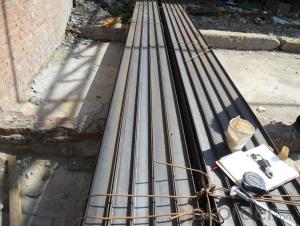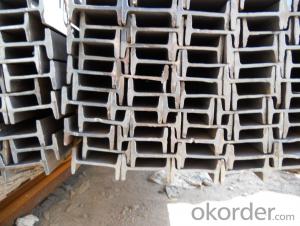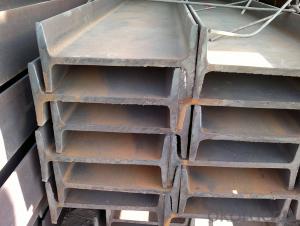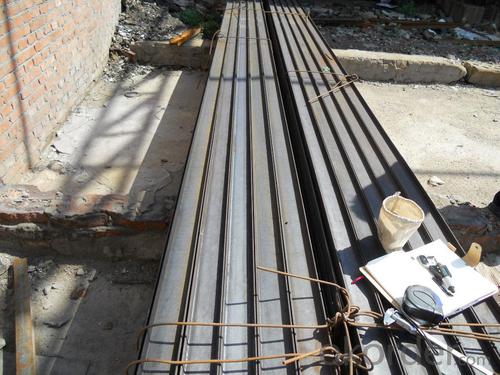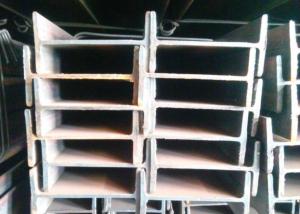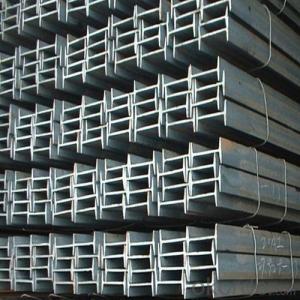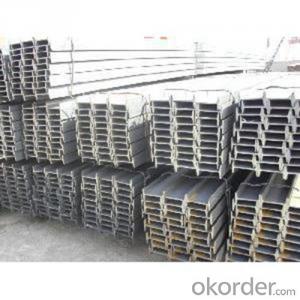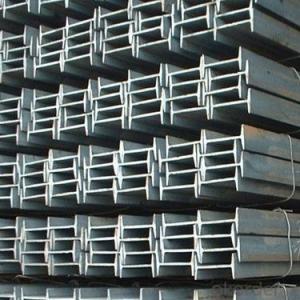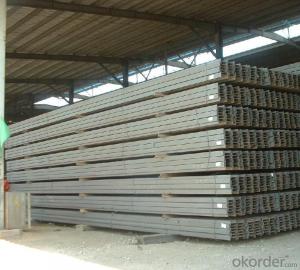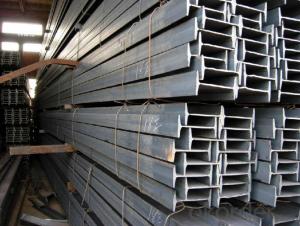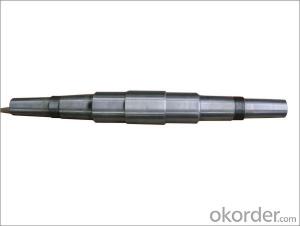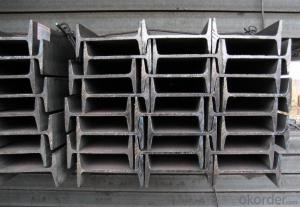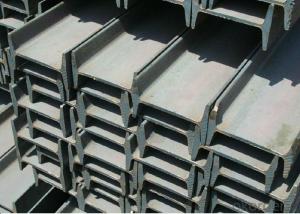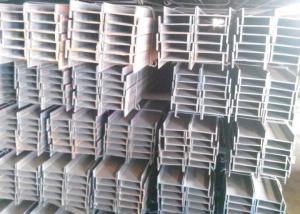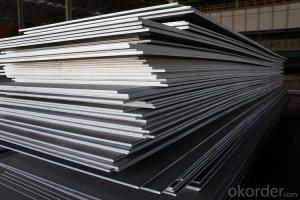Hot Rolled Steel I Beams for Construction from China
- Loading Port:
- Tianjin
- Payment Terms:
- TT OR LC
- Min Order Qty:
- 25 m.t
- Supply Capability:
- 200000 m.t/month
OKorder Service Pledge
OKorder Financial Service
You Might Also Like
Specification
Product Description:
OKorder is offering Hot Rolled Steel I Beams for Construction from China at great prices with worldwide shipping. Our supplier is a world-class manufacturer of steel, with our products utilized the world over. OKorder annually supplies products to European, North American and Asian markets. We provide quotations within 24 hours of receiving an inquiry and guarantee competitive prices.
Product Applications:
Hot Rolled Steel I Beams for Construction from China are widely used in various construction structures, bridges, autos, brackets, mechanisms and so on.
Product Advantages:
OKorder's Hot Rolled Steel I Beams for Construction from China are durable, strong, and resist corrosion.
Main Product Features:
· Premium quality
· Prompt delivery & seaworthy packing (30 days after receiving deposit)
· Corrosion resistance
· Can be recycled and reused
· Mill test certification
· Professional Service
· Competitive pricing
Product Specifications:
1. Product name: Hot Rolled Steel I Beams for Construction from China
2. Standard: EN10025, GB Standard, ASTM, JIS etc.
3. Grade: Q235B, A36, S235JR, Q345, SS400 or other equivalent.
4. Length: 5.8M, 6M, 9M, 10M, 12M or as your requirements
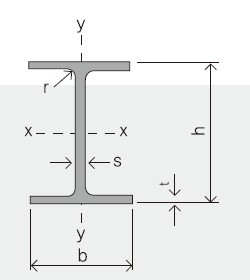
Section | Standard Sectional Dimensions(mm) | ||||
h | b | s | t | Mass Kg/m | |
IPE80 | 80 | 46 | 3.80 | 5.20 | 6.00 |
IPE100 | 100 | 55 | 4.10 | 5.70 | 8.10 |
IPE120 | 120 | 64 | 4.80 | 6.30 | 10.40 |
IPE140 | 140 | 73 | 4.70 | 6.90 | 12.90 |
IPE160 | 160 | 82 | 5.00 | 7.40 | 15.80 |
IPE180 | 180 | 91 | 5.30 | 8.00 | 18.80 |
IPE200 | 200 | 100 | 5.60 | 8.50 | 22.40 |
IPE220 | 220 | 110 | 5.90 | 9.20 | 26.20 |
IPE240 | 240 | 120 | 6.20 | 9.80 | 30.70 |
IPE270 | 270 | 135 | 6.60 | 10.20 | 36.10 |
IPEAA80 | 80 | 46 | 3.20 | 4.20 | 4.95 |
IPEAA100 | 100 | 55 | 3.60 | 4.50 | 6.72 |
IPEAA120 | 120 | 64 | 3.80 | 4.80 | 8.36 |
IPEAA140 | 140 | 73 | 3.80 | 5.20 | 10.05 |
IPEAA160 | 160 | 82 | 4.00 | 5.60 | 12.31 |
IPEAA180 | 180 | 91 | 4.30 | 6.50 | 15.40 |
IPEAA200 | 200 | 100 | 4.50 | 6.70 | 17.95 |
5.Color marking: There will be color marking on both end of the bundle for the cargo delivered by bulk vessel. That makes it easily to distinguish at the destination port.
Tag mark: there will be tag mark tied up on the bundles. The information usually including supplier logo and name, product name, made in China, shipping marks and other information request by the customer.
If loading by container the marking is not needed, but we will prepare it as customer request.
6. Shipment: In containers or in bulk cargo
FAQ:
Q1: Why buy Hot Rolled Steel I Beams for Construction from China from OKorder.com?
A1: All products are carefully selected from China's most reliable manufacturing enterprises. Through its ISO certifications, OKorder.com adheres to the highest standards and a commitment to supply chain safety and customer satisfaction. We can guarantee the quality!
Q2: The products are invoicing on theoretical weight or on actual weight?
A2: We can do it in both manners, it’s according to buyer's requirement.
Q3: Can you offer the third part inspection certificates ?
A3: Yes, we can apply third part inspection before shipping, such as SGS, BV, etc .
Images:
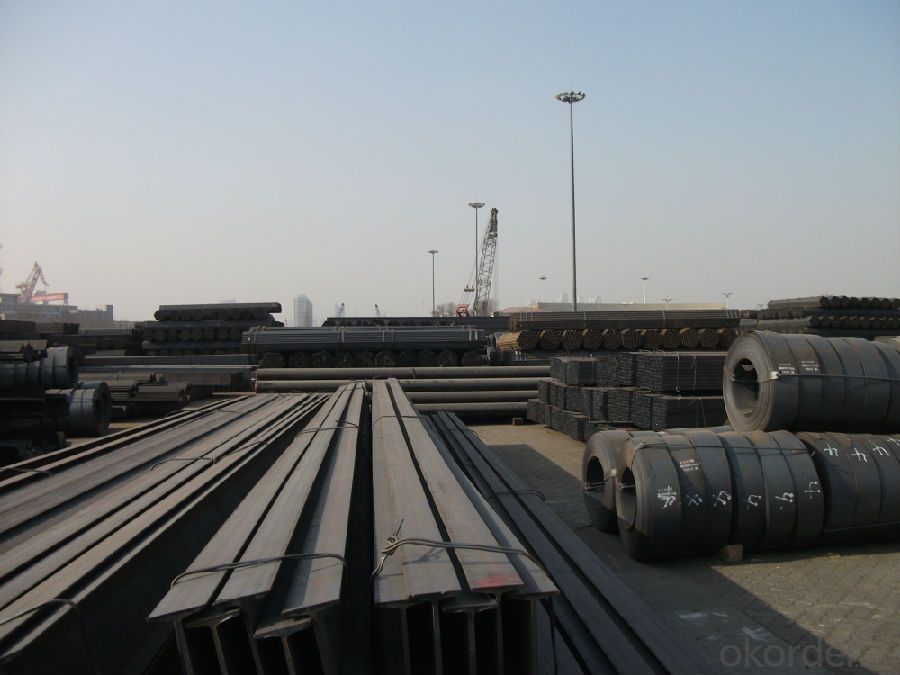
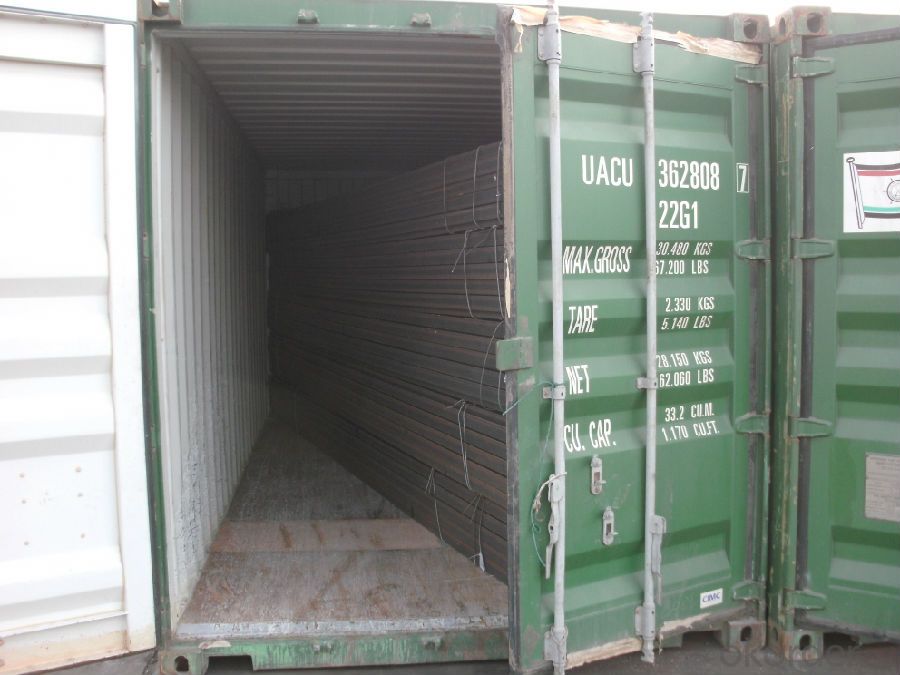
- Q: Can steel I-beams be used in the construction of residential homes?
- Yes, steel I-beams can be used in the construction of residential homes. They are often used as load-bearing elements for structural support due to their strength and durability. Additionally, steel I-beams allow for larger open spaces and flexible layouts in residential buildings.
- Q: Can steel I-beams be used in offshore platform construction?
- Certainly, the utilization of steel I-beams is feasible in the construction of offshore platforms. Due to their robustness and resilience, steel I-beams are frequently employed in this context. Given the adverse environmental factors encountered in offshore settings, such as strong winds, towering waves, and corrosive seawater, steel I-beams possess the capacity to endure these demanding conditions and offer indispensable structural reinforcement for the platform. Moreover, the simplicity of fabricating and assembling steel I-beams renders them an advantageous option for offshore platform construction.
- Q: Can steel I-beams be used in religious or worship facilities?
- Yes, steel I-beams can certainly be used in religious or worship facilities. Steel I-beams are commonly used in the construction industry due to their strength, durability, and versatility. They provide excellent structural support, allowing for large open spaces and wide spans, which can be ideal for religious or worship facilities that often have high ceilings or large gathering areas. In religious buildings, such as churches, temples, or mosques, steel I-beams can be utilized in various ways. They can be used to support the roof and create a stable framework for the entire structure. Additionally, they can be employed to construct mezzanines, balconies, or elevated platforms for choirs, organists, or other performers. Steel I-beams are also suitable for creating the framework of bell towers or spires, adding architectural appeal to the religious facility. Furthermore, steel I-beams can be used to construct large windows or skylights, allowing natural light to illuminate the worship space. Their strength and stability also make them suitable for supporting stained glass windows or intricate decorative elements. Moreover, steel I-beams can be hidden behind walls or ceilings, allowing for a seamless design that does not interfere with the aesthetic or spiritual ambiance of the religious facility. It is important to note that while steel I-beams are commonly used in religious or worship facilities, the specific design and construction considerations should be taken into account. Each religious facility may have unique architectural requirements or design preferences that should be discussed with architects, engineers, or construction professionals to ensure the proper integration of steel I-beams into the overall structure, while still respecting the sacred nature of the space.
- Q: How do steel I-beams contribute to the overall stability of a structure?
- Steel I-beams are a crucial component in enhancing the overall stability of a structure. These beams are specifically designed to carry and distribute the load of the building across its length, thereby preventing any unnecessary stress concentration on specific areas. The unique shape of an I-beam, with its flanges and web, provides it with exceptional strength and resistance to bending or twisting forces. One way in which steel I-beams contribute to stability is by providing structural support and minimizing the chances of a building collapsing. The horizontal flanges of the I-beam help distribute the weight of the structure evenly, making it capable of supporting large loads, including the weight of the building itself, as well as any additional live loads such as furniture, equipment, or people. This load distribution ensures that the structure remains stable and reduces the risk of any catastrophic failure. Moreover, steel I-beams are highly effective in resisting vertical and horizontal forces, such as wind or seismic loads. The strong and rigid nature of steel allows these beams to transfer these forces through the structure, preventing any excessive deflection or deformation. By withstanding these external forces, I-beams help maintain the integrity of the structure, protecting it from potential damage or collapse. Another advantage of steel I-beams is their long span capabilities. These beams can be fabricated to span significant distances without requiring intermediate supports. This eliminates the need for additional columns or walls, providing more flexibility in the design and utilization of the space. The absence of obstructions allows for open floor plans and maximizes the usable area of the structure. Furthermore, steel I-beams are highly durable and have a high strength-to-weight ratio. This means that they can withstand heavy loads while also being relatively lightweight compared to other construction materials. This advantage not only simplifies the construction process but also reduces the overall weight of the structure, resulting in cost savings and increased design flexibility. In summary, steel I-beams contribute to the overall stability of a structure by providing structural support, distributing loads evenly, resisting external forces, enabling long spans, and offering durability. Their unique design and material properties make them an essential component in ensuring the safety and stability of buildings in various applications, from residential homes to large-scale commercial or industrial structures.
- Q: What are the common types of connections for steel I-beams in moment frames?
- Steel I-beams in moment frames can be connected in various ways, including bolted, welded, and hybrid connections. Among the most commonly used connection types in moment frames are bolted connections. These connections involve securing the beams and columns together using bolts. To ensure a strong and rigid connection, the bolts are typically tightened to a specified torque. Another common type of connection for steel I-beams in moment frames is welded connections. In this type of connection, the beams and columns are joined together through a welding process, such as arc welding. Welded connections offer excellent strength and rigidity, but they require skilled welders to execute them correctly. Hybrid connections, on the other hand, combine both bolted and welded connections. This type of connection is often employed when different parts of the moment frame necessitate different connection methods. For instance, bolted connections may be utilized for the primary beam-to-column connections, while welded connections may be suitable for secondary bracing members. It should be emphasized that the choice of connection type in a steel moment frame depends on several factors, including design requirements, loading conditions, and the overall structural configuration. It is crucial to adhere to industry standards and guidelines when selecting the connection type to ensure the moment frame's safety and structural integrity.
- Q: What are the typical spans achievable with steel I-beams?
- The achievable spans of steel I-beams can vary depending on several factors, including the size and shape of the beam, the load it must support, and the design specifications of the structure in which it is utilized. Steel I-beams are renowned for their strength and ability to bear weight, making them a favored option for various construction endeavors. Generally speaking, steel I-beams can achieve spans that range from a few feet to several hundred feet. For smaller residential or commercial projects, spans of 20-30 feet are commonly seen. In larger commercial or industrial buildings, steel I-beams can achieve spans of 40-60 feet or more. Nevertheless, it is important to recognize that these are merely typical spans and not absolute limitations. By employing proper engineering and design considerations, steel I-beams can be utilized to achieve even longer spans. Adjustments to factors such as the beam's depth, flange width, and thickness can enhance its load-bearing capacity and extend its span capabilities. Ultimately, the attainable spans of steel I-beams are contingent upon the specific requirements and limitations of a particular project. Seeking guidance from a structural engineer or a professional in the realm of steel construction is essential in determining the appropriate beam size and span for a given application.
- Q: Are steel I-beams cost-effective compared to other structural options?
- Comparatively, steel I-beams are a cost-effective option when compared to alternative structural choices. Steel, being an incredibly durable and versatile material, offers numerous advantages in terms of strength, load-bearing capacity, and longevity. A notable feature of steel I-beams is their exceptional strength-to-weight ratio, allowing them to bear heavy loads while utilizing minimal material. This not only reduces construction expenses but also maximizes available space efficiency. Moreover, steel is readily accessible, making it a more convenient and cost-effective sourcing option when compared to other alternatives. Additionally, steel is highly recyclable, making it an environmentally conscious choice. The longevity of steel I-beams ensures a prolonged lifespan, reducing the need for frequent repairs or replacements, thereby further contributing to their cost-effectiveness. Furthermore, steel structures can be prefabricated, resulting in reduced construction time and labor expenses. The ease of assembly and modular nature of steel I-beams make them suitable for a wide range of applications, including residential, commercial, and industrial projects. However, it is crucial to acknowledge that the cost-effectiveness of steel I-beams may vary depending on various factors, such as project requirements, design complexity, and regional material availability. Therefore, it is advisable to consult with structural engineers and construction professionals to accurately assess the specific needs and constraints of a project and determine the most cost-effective solution.
- Q: How do steel I-beams compare to reinforced concrete beams in terms of cost and performance?
- Steel I-beams and reinforced concrete beams both have their own advantages and disadvantages when it comes to cost and performance. In terms of cost, steel I-beams tend to be more expensive upfront compared to reinforced concrete beams. The cost of steel fabrication and installation is typically higher, especially when considering factors such as labor, transportation, and specialized equipment. On the other hand, reinforced concrete beams are generally more cost-effective initially, as the materials used are relatively inexpensive and readily available. However, it's important to note that the long-term maintenance and repair costs for reinforced concrete beams can be higher, as concrete may require regular inspections and potential repairs due to cracks or deterioration. Performance-wise, both steel I-beams and reinforced concrete beams have their own strengths. Steel I-beams are known for their high tensile strength, which means they can withstand heavy loads and provide excellent structural support. They are also more flexible and can be easily modified or adjusted if needed. On the other hand, reinforced concrete beams are known for their durability, fire resistance, and ability to withstand extreme weather conditions. They have good compressive strength and can handle high loads as well, but their tensile strength is comparatively lower. Ultimately, the choice between steel I-beams and reinforced concrete beams depends on various factors such as the specific project requirements, design considerations, budget constraints, and local building codes. It's crucial to consult with structural engineers and professionals in order to determine the most cost-effective and performance-oriented solution for a particular construction project.
- Q: What's the name of the U steel for the fixed I-beam?
- There is also a U type, that is, C steel, but not commonly used. It would be better if there were pictures.
- Q: What are the tensile, shear, Xu Yun, and Xu Yun deflections of 20a I-beam?
- Standard design of steel structure is the total probability method, the design strength of Q235 steel plate is 215N/mm2 tensile shear stress, the load is 125N/mm2, the situation is not clear when don't use this!
Send your message to us
Hot Rolled Steel I Beams for Construction from China
- Loading Port:
- Tianjin
- Payment Terms:
- TT OR LC
- Min Order Qty:
- 25 m.t
- Supply Capability:
- 200000 m.t/month
OKorder Service Pledge
OKorder Financial Service
Similar products
Hot products
Hot Searches
Related keywords
